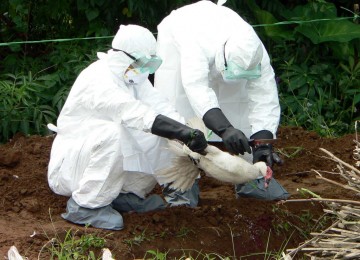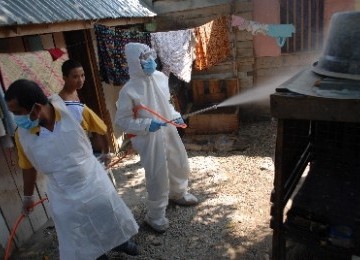New coronavirus can infect cells from multiple species
Dec 11, 2012 (CIDRAP News) – Experiments on the novel coronavirus that has infected patients from three Middle Eastern countries show that the receptor it uses to infect human cells is different from the one used by its relative the SARS virus and that it can infect cells from a range of animals, according to a study released today.
Both findings have implications for public health, as experts rush to assess the threat and develop tools to battle the emerging virus, which has so far led infected at least 9 people, causing 5 deaths, in Saudi Arabia, Qatar, and Jordan. The study was conducted by researchers from Germany and the Netherlands and appears today in mBio, the online journal of the American Society for Microbiology (ASM).
The virus, called hCoV-EMC, has been linked to two illness clusters, including one that involved healthcare workers at a Jordanian hospital. All of the patients with confirmed infections had pneumonia, and several had severe renal complications.
The European Centre for Disease Prevention and Control (ECDC) said recently that though the case clusters raise the possibility of human-to-human transmission, so far there is too little information to confirm or rule it out. Regardless, concerns about transmission risk have prompted intensive monitoring of close contacts of case-patients and reminders about steps to protect healthcare workers.
Christian Drosten, MD, lead author
of the study and director of the Institute of Virology at the University of Bonn Medical Centre in Germany, said in an ASM press release today, "This virus is closely related to the SARS virus, and looking at the clinical picture, it causes the same pattern of disease."
One question the research team wanted to explore was whether the hCoV-EMC and SARS viruses use the same receptor to enter human cells. The SARS virus uses the angiotensin-converting enzyme 2 (ACE2) receptor, which is mainly found on pneumocytes deep in human lungs. Drosten said individuals needed to inhale great numbers of SARS viruses for enough to reach deep into the lungs and take root, a factor that limited its spread mainly to healthcare workers and people who lived in overcrowded housing in Hong Kong.
The researchers found that hCoV-EMC clearly does not use ACE2, Drosten said in the press release But the virus could use another, still-unknown receptor in human lungs that is easier to access and could make the virus more infectious than SARS, he added.
In the second part of the study, the group conducted a set of experiments to shed light on how the virus might have originated and moved between humans and animals. Genetic sequencing of an hCoV-EMC sample from a Saudi man who died in June showed that the virus most closely resembles coronaviruses found in bats. Some of the patients with confirmed infections had visited farms before they got sick.
Drosten said the SARS virus changed after it jumped from bats to civets to humans, rendering it unable to infect bats again. However, he said researchers were surprised to see that hCoV-EMC can infect cells from many different species. The group found that it could enter cells from four major bat families, pigs, and primates. "It's completely unusual for any coronavirus to be able to do that—to go back to its original reservoir," he said.
The team reported that the findings suggests all the animals could share a common receptor, and if the receptor is present on mucosal surfaces such as the lining of the lung, the virus could pass back and forth between animals and humans, making it difficult or even impossible to eliminate.
Drosten said his lab is still trying to identify the hCoV-EMC receptor and that more work on the virus is under way at many other hospitals and labs.
Kathryn Holmes, PhD, professor emerita in the University of Colorado School of Medicine's Department of Microbiology, told CIDRAP News that the group's findings are exciting news. She is a coronavirus expert whose work has focused on characterizing receptors for several coronaviruses.
She said there are several different receptor proteins for coronaviruses and it will be interesting to see what the receptor or receptors are for the new coronavirus. It's not possible, she added, to predict the receptor solely from the genetic sequence of the virus' spike protein, the glycoprotein that mediates its entry into host cells. \
The discovery that the virus grows well in multiple species without adaptation is important, but it does not necessarily predict whether each of the species is sickened by the virus, she said.
Scientists have a lot of questions to answer about the new virus, such as its tissue tropism, virulence mechanism, and transmission routes, Holmes said, adding, "It is amazing how quickly data from this newly discovered virus is flowing from many labs."
Rapid identification of reservoir hosts, routes of transmiss
ions, and virulence determinants in different hosts will help reduce human contact with potential animal reservoirs, and sensitive assays to detect viral RNA and proteins are being developed and used to analyze the epidemiology of the virus in humans and animals, Holmes said.
She said the virus has apparently been discovered before any widespread in humans, and current research will establish assays to allow health officials to rapidly evaluate any potential spread of the new virus to new hosts or different regions or from human to human.
Muller MA, Raj VS, Muth D, et al. Human coronavirus EMC does not require the SARS-coronavirus receptor and maintains broad replicative capability in mammalian cell lines. mBio 2012 Dec 11 [Abstract]
See also:
Dec 11 ASM press release http://www.cidrap.umn.edu/cidrap/content/other/sars/news/dec1112receptor.html
 Staff Writer
Staff Writer

 Like SARS, the new virus is most closely related to coronaviruses from bats. (Kin Cheung/Reuters)
Like SARS, the new virus is most closely related to coronaviruses from bats. (Kin Cheung/Reuters)


